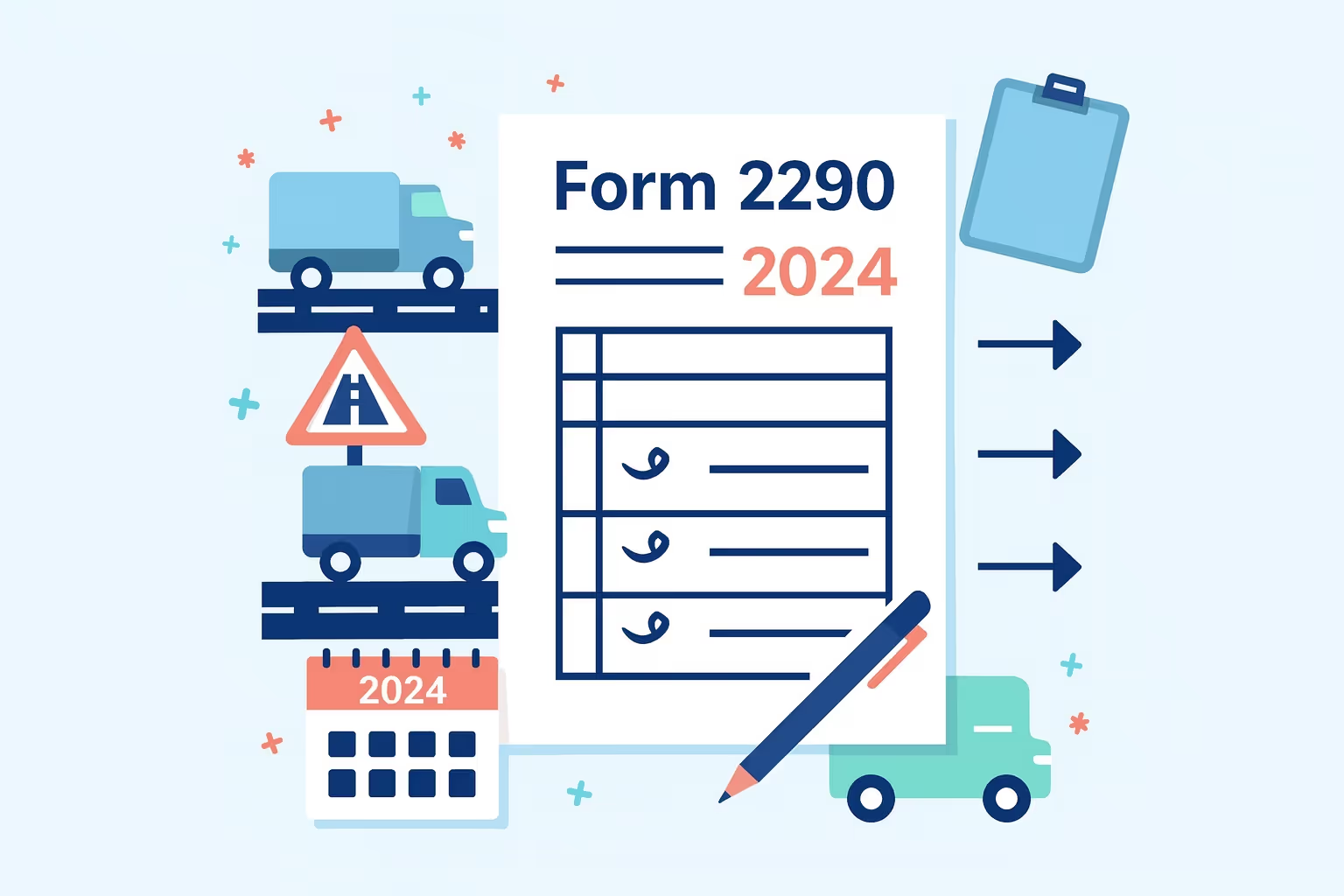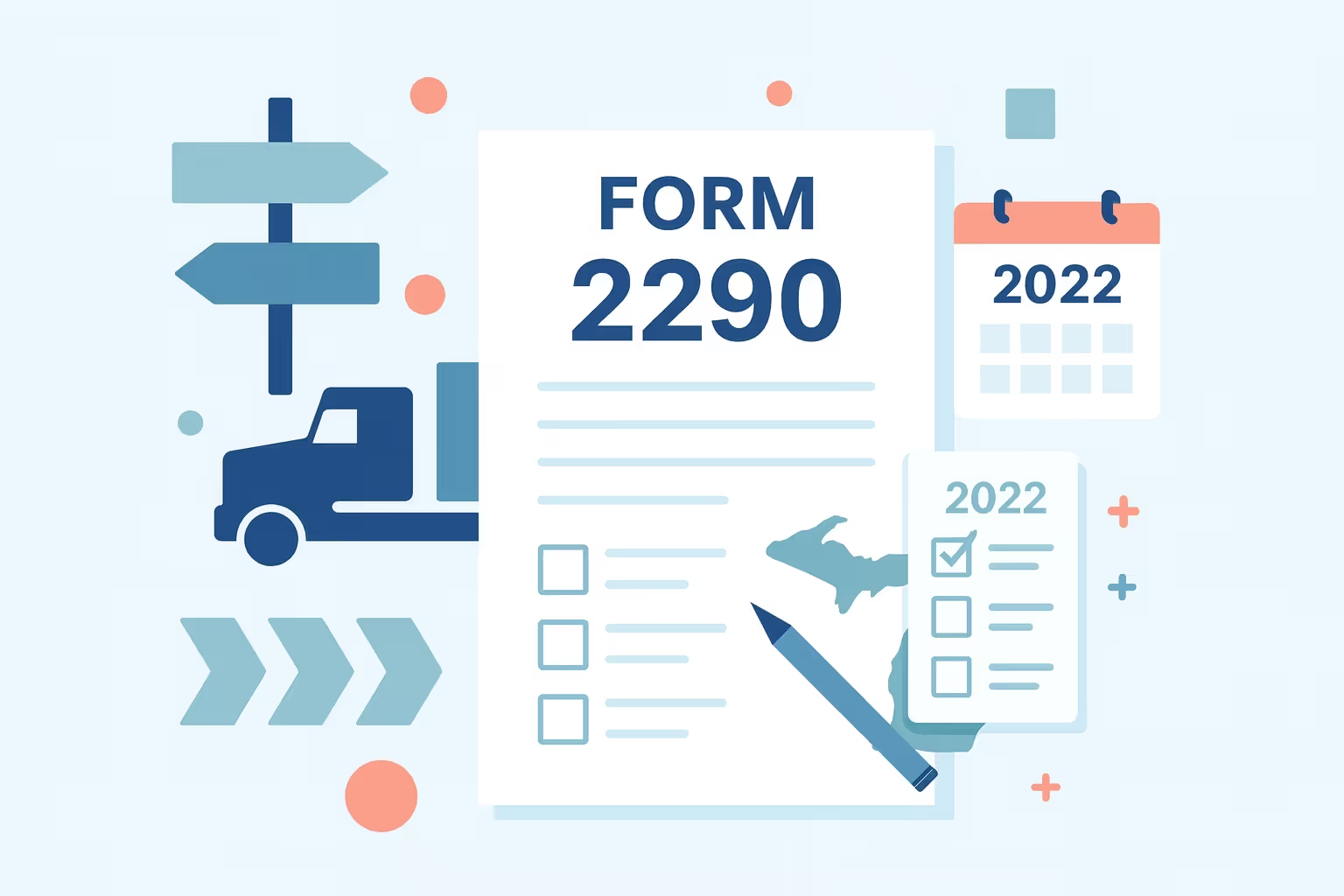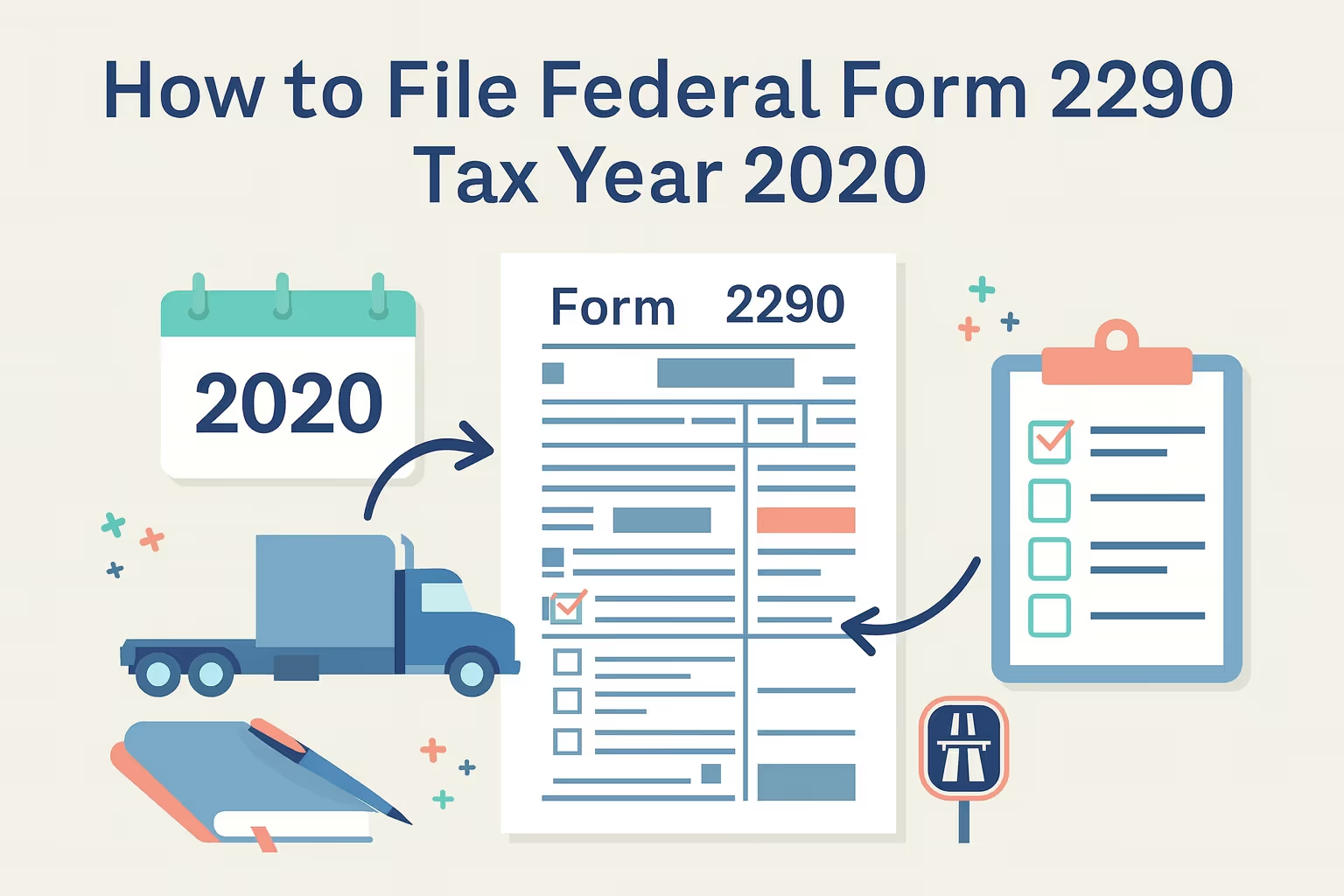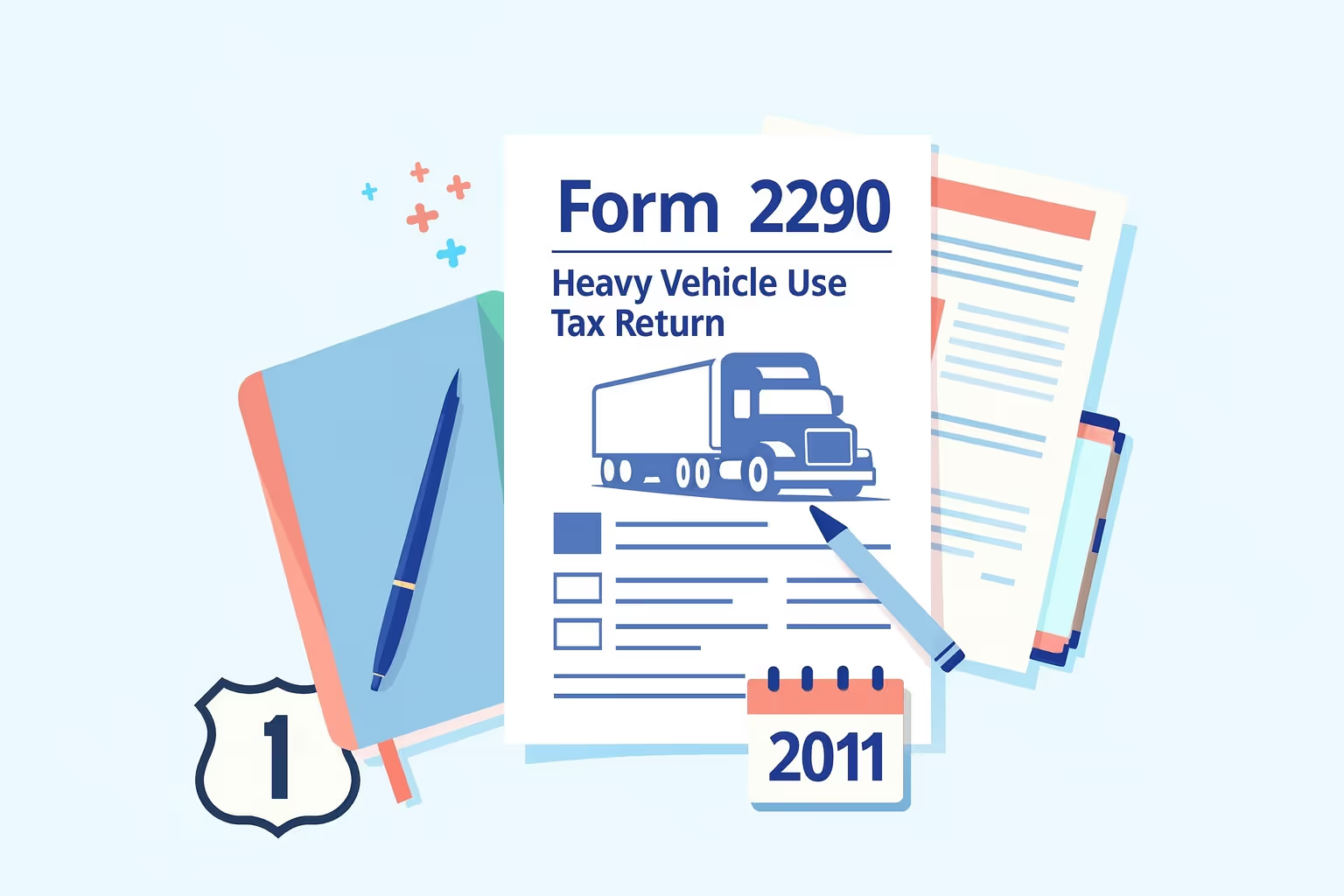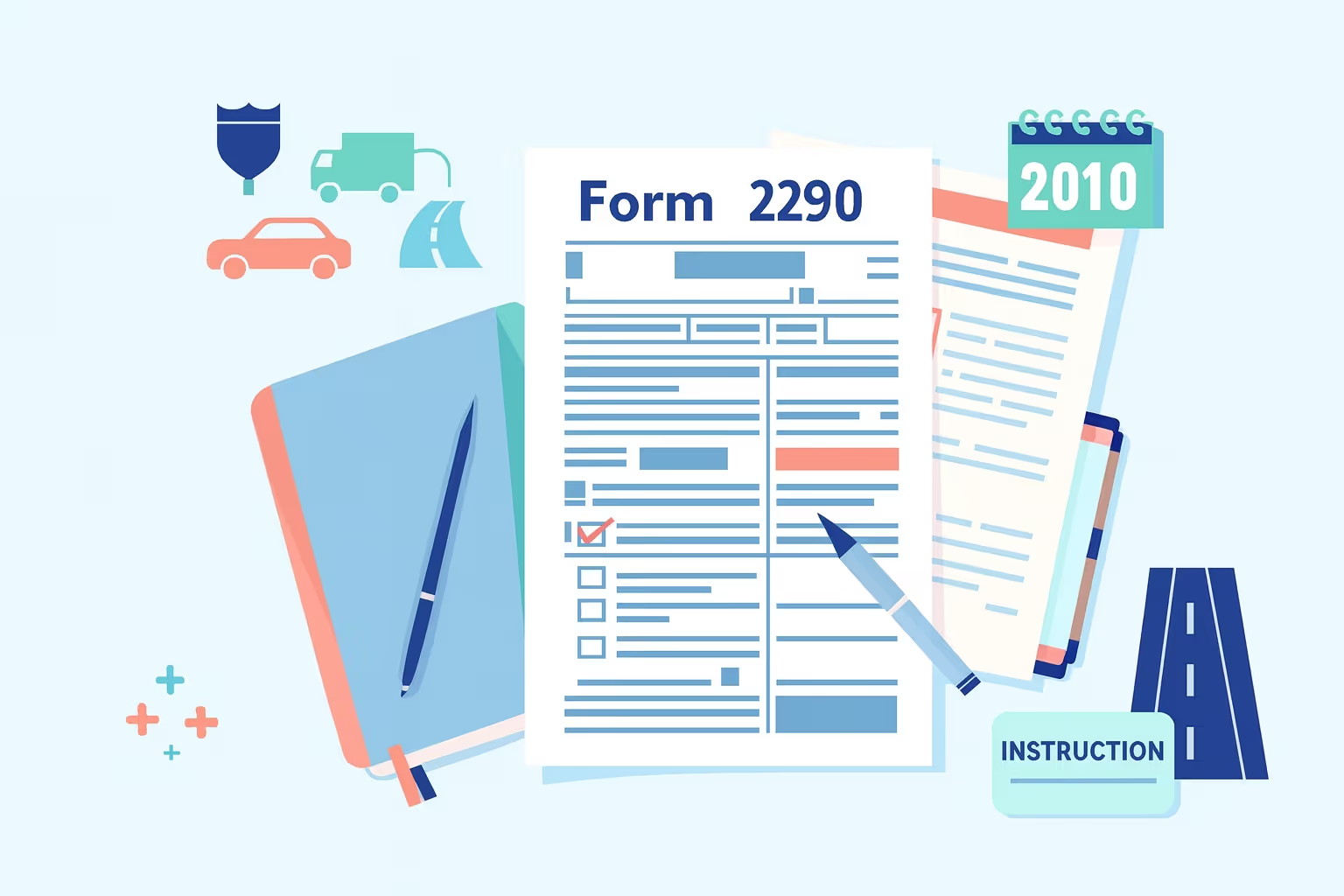Form 2290 2016 Instructions: Step-by-Step IRS Guide
Form 2290 2016 instructions help taxpayers understand how to file the Heavy Highway Vehicle Use Tax Return required by the Internal Revenue Service. This tax form applies to highway motor vehicles with a taxable gross weight of 55,000 pounds or more that operate on public roads. It ensures that owners and operators of heavy highway vehicles contribute to the maintenance of the nation’s highways.
For the 2016 tax period, the filing covers vehicles used between July 1, 2016, and June 30, 2017. Anyone who registers a taxable car during this period is required to file an IRS Form 2290 and pay the corresponding tax. The process involves determining the vehicle’s weight category, calculating the fee, and completing the necessary sections, including the suspension statement when applicable.
This guide provides step-by-step instructions on how to accurately prepare, file, and pay the heavy vehicle use tax. It explains the difference between e-filing and paper-filing options, how to complete Schedule 1, and how to avoid common mistakes. Designed for clarity and simplicity, it helps filers—especially first-time users—navigate the process confidently while ensuring compliance with IRS requirements.
What Is Form 2290 and Who Needs to File It?
Form 2290, also known as the Heavy Highway Vehicle Use Tax Return, is an IRS form used to report and pay the vehicle use tax for heavy highway vehicles. It applies to trucks, truck tractors, and buses with a taxable gross weight of 55,000 pounds or more that are operated on public highways. The tax collected from this return helps fund highway construction and maintenance across the United States.
Who Must File Form 2290?
The following taxpayers are required to file Form 2290 and pay the tax:
- Individuals or businesses that own or operate taxable highway motor vehicles registered under their name in the United States, the District of Columbia, Canada, or Mexico.
- Operators who first use a taxable vehicle during the tax period of July 1, 2016, through June 30, 2017.
- Truck owners whose vehicles fall within a new category because of a vehicle weight or a change in use.
Vehicles Exempt from the Tax
Specific cars are not subject to the heavy highway vehicle use tax:
- Vehicles owned and used by the federal, state, or local government, including the District of Columbia.
- Vehicles operated by the American National Red Cross or other nonprofit volunteer organizations, such as fire departments or rescue squads.
- Agricultural vehicles that are used primarily for farming and meet mileage use limit requirements of 7,500 miles or less during the tax period.
Purpose of the Form
Form 2290 allows taxpayers to report the acquisition of new vehicles, pay the tax due, or claim suspension when a car is expected to remain below the mileage use limit. It is also used to report taxable cars acquired during the year, report when a vehicle is sold, destroyed, or stolen, and figure the tax owed if a car falls into a higher weight category.
Understanding who must file and which vehicles qualify ensures that taxpayers meet IRS filing and payment obligations accurately. Completing this form correctly also helps avoid penalties and ensures that credits or refunds are adequately applied when a heavy highway vehicle is sold, suspended, or exceeds its expected mileage.
What’s New in the 2016 Form 2290?
For the 2016 tax year, most of the core requirements and calculations for the Heavy Highway Vehicle Use Tax remained unchanged. However, taxpayers should note several important reminders and updates when reviewing the Form 2290 2016 instructions.
Key updates and reminders for filers include:
- Electronic filing is required for each return reporting 25 or more vehicles. This ensures faster processing and reduced filing errors.
- Tax rates for the 2016 tax period remained the same, with the maximum annual tax of $550 for vehicles with the highest taxable gross weight.
- An Employer Identification Number (EIN) is required to complete the filing. The IRS no longer accepts Social Security Numbers for form submission.
- Schedule 1 must be filed in duplicate. One copy will be stamped and returned by the IRS as proof of payment.
- Filers should always use Form 2290 (Rev. July 2016) to report tax information for the correct year, thereby avoiding delays or rejections.
These reminders ensure that taxpayers remain compliant with the IRS filing requirements for the 2016 period and that all payments and suspensions are recorded accurately.
Pre-Filing Checklist: What You Need Before Starting
Before completing the IRS Form 2290, filers should gather specific information and documents to streamline the process. Preparing these details in advance helps reduce filing errors and ensures accurate reporting.
Essential information to prepare includes:
- Employer Identification Number (EIN). This number is required for all taxpayers and cannot be substituted with a Social Security Number.
- Vehicle Identification Number (VIN) for each taxable vehicle. The VIN uniquely identifies each vehicle reported on the tax return.
- The taxable gross weight of each vehicle. This determines the tax rate and category for each heavy highway vehicle.
- The date each vehicle was first used on public highways during the tax period. This helps establish the correct filing and payment deadline.
- Details about vehicles expected to qualify for suspension. Filers should identify cars that will travel 5,000 miles or less during the tax period, or 7,500 miles or less for agricultural vehicles, during the tax period.
- Records or documentation showing whether any taxable vehicle was sold, destroyed, or stolen during the tax year.
Completing this checklist ensures the information on the tax form is correct, avoiding penalties and the need for amendments later. It also helps taxpayers determine if they need to claim suspension or report the acquisition of a taxable vehicle.
Step-by-Step Instructions for Filing Form 2290
Filing Form 2290 requires several steps to ensure accuracy and compliance. Each step helps taxpayers accurately report their vehicle use tax and meet all IRS filing requirements.
Step 1 – Determine if Filing Is Required.
Filers must complete Form 2290 if they own or operate highway motor vehicles that have a taxable gross weight of 55,000 pounds or more. The vehicle must be registered under the taxpayer’s name and used on public highways during the tax period.
Step 2 – Identify the Vehicle Category.
Every heavy vehicle falls within a specific weight category listed in the IRS tax computation table. The category determines the amount of tax due.
- Vehicles used exclusively for logging or transporting forest products are subject to a lower tax rate.
- Agricultural vehicles may qualify for mileage suspension if they are used 7,500 miles or fewer during the period.
- Suspended vehicles must be listed under Category W on Schedule 1.
Step 3 – Calculate the Taxable Gross Weight.
The taxable gross weight is calculated by adding the following:
- The actual unloaded weight of the fully equipped vehicle.
- The unloaded weight of trailers or semitrailers is typically used in conjunction with the vehicle.
- The weight of the maximum load customarily carried on the vehicle and its trailers.
For buses, 150 pounds must be added for each seat, including the driver’s seat.
Step 4 – Complete Form 2290.
Filers must complete each section of the form accurately:
- The header requires the taxpayer’s name, address, and EIN.
- Part I is used to figure the tax based on the taxable gross weight and the number of vehicles.
- The suspension statement section is used to claim suspension for vehicles that meet mileage limits.
- The signature section must be signed and dated to validate the filing.
Step 5 – Complete Schedule 1.
Schedule 1 must be completed in duplicate and submitted with the form.
- Each vehicle’s VIN and category must be listed accurately.
- Category W must be used for vehicles that qualify for suspension.
- The IRS will return one stamped copy of Schedule 1 as proof that the tax was paid.
Following these steps ensures accurate reporting and compliance with all IRS requirements. It also helps filers avoid errors when reporting the acquisition of a new taxable vehicle, claiming a suspension, or calculating the correct tax amount.
Filing Methods: Electronic vs. Paper Filing
Taxpayers can file Form 2290 using either electronic filing or traditional paper submission, depending on their circumstances. Both options require the same information, but electronic filing is generally faster and more convenient.
Electronic Filing (e-filing)
Electronic filing is required for filers reporting 25 or more vehicles during the tax period. This option is also recommended for anyone who wants a quicker confirmation of payment.
- Taxpayers must find an IRS-approved e-file provider that supports the Heavy Highway Vehicle Use Tax return.
- The filer submits all details, including vehicle identification numbers, taxable gross weight, and payment method, through the e-file provider’s system.
- Upon acceptance, the IRS provides an electronic copy of the stamped Schedule 1, usually within minutes.
- E-filing reduces errors, offers secure payment options, and provides faster proof of payment for vehicle registration.
Paper Filing
Paper filing is available for taxpayers reporting fewer than 25 vehicles or those who prefer traditional submission.
- Filers must complete Form 2290 and both copies of Schedule 1 by hand or electronically before printing the forms.
- Payments made by check or money order must include the Form 2290-V payment voucher.
- Returns with payments should be mailed to the IRS's P.O. Box in Cincinnati, OH. Returns without payments should be sent to the main IRS processing center.
- Paper filing requires several weeks of processing time before receiving the stamped Schedule 1.
Choosing between electronic and paper filing depends on the number of vehicles, preferred payment method, and desired processing speed. Most taxpayers find that e-filing saves time and helps avoid common form errors.
How to Pay the 2290 Heavy Vehicle Use Tax?
The IRS allows multiple payment methods to accommodate taxpayers with different preferences. Every filer must pay the full amount owed by the due date based on the first month of vehicle use.
Accepted Payment Methods
- Electronic Funds Withdrawal (EFW): Taxpayers using e-filing can authorize payment directly from their bank account during the submission process. This option provides immediate confirmation of payment.
- Electronic Federal Tax Payment System (EFTPS): Filers can make secure electronic payments through www.eftps.gov. Enrollment is required before use, and payments can be scheduled in advance.
- Check or Money Order: Paper filers may pay by mail. The check or money order must be made payable to the United States Treasury and include the filer’s EIN, the words “Form 2290,” and the tax period.
Payment Deadlines
The payment due date depends on when a vehicle is first used during the tax period. The tax must be paid by the last day of the month following the first month of use.
- A vehicle first used in July 2016 must be paid for by August 31, 2016.
- A vehicle first used in August 2016 must be paid for by September 30, 2016.
- For vehicles first used in later months, the same rule applies: payment is due by the end of the following month.
- The IRS does not permit installment payments for the heavy highway vehicle use tax.
Timely payment ensures compliance with IRS requirements and prevents penalties or interest. Taxpayers who use electronic payment options generally receive faster confirmation and avoid mailing delays.
Common Filing Errors to Avoid
Many taxpayers encounter preventable mistakes when filing their Form 2290. Paying attention to common issues helps ensure that the tax return is processed quickly and correctly.
Frequent errors include:
- Using a Social Security Number instead of an Employer Identification Number. Only an EIN is accepted on the IRS Form 2290.
- Entering incorrect Vehicle Identification Numbers. A single error can delay the issuance of the stamped Schedule 1.
- Using the wrong tax period or an outdated form. Filers must always use Form 2290 (Rev. July 2016) for the 2016 tax year.
- Forgetting to sign the return. Unsigned paper forms are considered incomplete and will be rejected.
- Omitting both copies of Schedule 1. The IRS must receive both copies to return one stamped as proof of tax paid.
- Making late payments or submitting incorrect amounts. Taxpayers must figure the correct tax based on each vehicle’s taxable gross weight category.
- Filing both electronic and paper returns for the identical vehicles. Duplicate filings can lead to processing delays or raise concerns about potential overpayment.
Reviewing all details before submission helps filers avoid delays, penalties, and correspondence with the IRS. Taxpayers who verify information and double-check their calculations are more likely to receive their stamped Schedule 1 promptly.
Filing for Suspended or Low-Mileage Vehicles
Some vehicles may qualify for a suspension from the heavy highway vehicle use tax if they meet specific mileage requirements. A suspended vehicle is expected to be used 5,000 miles or less during the tax period, or 7,500 miles or less if classified as an agricultural vehicle. Although these vehicles are exempt from paying tax, they must still be reported on Form 2290.
To claim suspension, the filer must:
- List the qualifying vehicle under Category W on Schedule 1.
- Complete the suspension statement section of the form.
- Keep accurate mileage records to prove that the mileage use limit has not been exceeded.
- File an amended return and pay the tax if the vehicle later exceeds the mileage limit.
Special rules apply for agricultural vehicles:
- These vehicles must be used primarily for farming purposes and cannot exceed 7,500 miles during the tax period.
- If the mileage limit is exceeded, the taxpayer must figure the tax due and file an amended return immediately.
Filers should maintain detailed records for at least three years, including logs that show total miles driven, routes used, and dates of vehicle use. Proper recordkeeping ensures compliance and helps resolve any future questions regarding suspension eligibility.
Guidance for First-Time Filers
Taxpayers filing Form 2290 for the first time must take several necessary steps to ensure that their return is accepted and processed without delays.
Essential steps for new filers include:
- Apply for an Employer Identification Number (EIN) if one has not been issued. The IRS will not accept a Social Security Number on the form.
- Determine the correct tax period, which for 2016 runs from July 1, 2016, through June 30, 2017.
- Identify the first month that the vehicle was used on public highways, as this determines the filing and payment deadline.
- Choose the preferred filing method, either e-filing or paper submission, based on the number of vehicles and convenience.
- Gather complete vehicle information, including taxable gross weight, VIN, and whether any vehicle is expected to qualify for suspension.
- Review all data before submission to avoid mistakes that could delay receipt of the stamped Schedule 1.
New filers are encouraged to file electronically, as it provides immediate confirmation, faster turnaround times, and fewer errors compared to paper filing. Understanding how to report the acquisition of a taxable vehicle or how to claim suspension ensures that first-time filers remain compliant with all IRS requirements.
Proof of Payment and Recordkeeping Requirements
The IRS-stamped Schedule 1 serves as official proof that a taxpayer has paid the vehicle use tax. Truck owners and operators must present this document when renewing vehicle registration, transferring ownership, or crossing international borders with a taxable vehicle.
Key points regarding proof of payment:
- Taxpayers who e-file will receive their stamped Schedule 1 electronically within minutes after submission and payment confirmation is received.
- Paper filers will receive one stamped copy of Schedule 1 by mail after their return is processed.
- The Schedule 1 must list all taxable vehicles by VIN and category, including any suspended vehicles.
Recordkeeping requirements:
- Filers must retain copies of the completed Form 2290, Schedule 1, and all payment records for a minimum of three years after the tax period.
- Records should include mileage logs for suspended or agricultural vehicles, proof of tax paid, and any supporting documentation for credits or refunds.
- Additional documents should be retained if a vehicle was sold, destroyed, or stolen, as they may be required to support a claim or credit.
Maintaining complete records protects taxpayers in the event of an IRS audit and ensures they can demonstrate compliance during vehicle registration or ownership changes. Proper documentation is a crucial component of responsible tax reporting for heavy highway vehicle operators.
Sources and Compliance Note
All information in this guide is based on official IRS materials for the 2016 tax period. Taxpayers should always refer to the most recent IRS publications for updates, as requirements and electronic filing options are subject to change from year to year.
Primary sources include:
- Form 2290 (Rev. July 2016), Heavy Highway Vehicle Use Tax Return.
- Instructions for Form 2290 (Rev. July 2016), published by the Internal Revenue Service.
- IRS website at www.irs.gov for current forms, e-filing providers, and payment options.
This guide is intended for educational purposes only. It helps taxpayers understand the Form 2290 2016 instructions and filing process, but should not be considered legal or financial advice. Taxpayers with specific questions or complex filing concerns should contact the IRS or a qualified tax professional for further assistance.
Frequently Asked Questions
What is Form 2290, and who is required to file it?
Form 2290 is an IRS form used by taxpayers to report and pay the federal vehicle use tax on highway motor vehicles with a taxable gross weight of 55,000 pounds or more. Any person or business that registers a taxable car during the tax period must complete this tax return. Filing ensures that heavy highway vehicles contribute to maintaining public roads and meet the federal tax requirements set for each period.
What does the 2016 Form 2290 cover?
The Form 2290 2016 instructions apply to the tax period beginning July 1, 2016, and ending June 30, 2017. Filers must use this version of the form to report the acquisition of a taxable vehicle, pay the heavy vehicle use tax, or claim suspension if the vehicle is expected to stay below the mileage use limit. Taxpayers should use accurate information to avoid errors and ensure that their tax returns are processed correctly.
Can the tax be suspended for low-mileage or agricultural vehicles?
Yes, a taxpayer can claim suspension for a vehicle expected to be used 5,000 miles or less during the tax period, or 7,500 miles or less if it qualifies as an agricultural vehicle. The suspension statement must be completed on the form, and the care listed under Category W on Schedule 1. If the mileage use limit is exceeded, the taxpayer must file an amended return and pay the required tax.
How is the heavy highway vehicle use tax calculated?
The vehicle use tax is calculated based on the taxable gross weight of each vehicle and its category as outlined in the IRS schedule. Trucks and tractors that weigh 55,000 pounds or more fall into different weight ranges, each assigned a specific fee. If a vehicle increases in weight or moves into a new category during the year, the taxpayer must report the change and pay the additional tax due for the remainder of the period.
What proof is provided after filing Form 2290?
After the IRS Form 2290 is submitted and tax paid, the filer receives a stamped Schedule 1 as official proof of payment. E-filing provides the stamped copy electronically within minutes, while paper returns take longer to process. Schedule 1 lists all taxable vehicles, including those that are suspended, and must be presented when renewing vehicle registration or transferring ownership within the District of Columbia or any other state jurisdiction.
What should be done if a taxable vehicle is sold, stolen, or destroyed?
When a taxable vehicle is sold, destroyed, or stolen before the end of the tax period, taxpayers may claim a credit or refund for the unused portion of the tax paid. The filer must report the acquisition of any replacement vehicle and file a new form if applicable. Proper documentation and records must be kept to verify the vehicle’s status and ensure compliance with IRS requirements.
How long should records and completed forms be kept?
Taxpayers should keep all completed forms, proof of tax paid, and related records for at least three years from the date the return is filed. Records should include mileage logs, details of suspended or agricultural vehicles, and documents supporting any credit or claim. These files are essential if the IRS requests verification or if the filer needs to reference previous returns for trucks sold, stolen, or destroyed during a prior period.
















